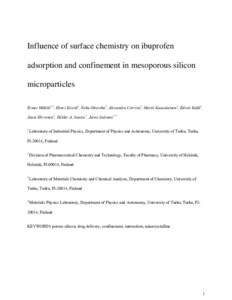Influence of Surface Chemistry on Ibuprofen Adsorption and Confinement in Mesoporous Silicon Microparticles
Correia A; Hirvonen J; Kaasalainen M; Kivela H; Kukk E; Makila E; Salonen J; Santos HA; Shrestha N
Influence of Surface Chemistry on Ibuprofen Adsorption and Confinement in Mesoporous Silicon Microparticles
Correia A
Hirvonen J
Kaasalainen M
Kivela H
Kukk E
Makila E
Salonen J
Santos HA
Shrestha N
AMER CHEMICAL SOC
Julkaisun pysyvä osoite on:
https://urn.fi/URN:NBN:fi-fe2021042716172
https://urn.fi/URN:NBN:fi-fe2021042716172
Tiivistelmä
The effect of adsorption and confinement on ibuprofen was studied by immersion loading the molecules into porous silicon (PSi) microparticles. The PSi micro particles were modified into thermally oxidized PSi (TOPSi) and thermally hydrocarbonized PSi (THCPSi) to evaluate the effects of the loading solvent and the surface chemistry on the obtainable drug payloads. The payloads, location, and the molecular state of the adsorbed drug were evaluated using thermal analysis. The results showed that after the adsorption of similar to 800 mg/cm(3) (w(drug)/v(pores)) of drug into the mesopores, depending on the solvent used in the immersion, the drug began to rapidly recrystallize on the external surface of the particles. Moderate concentrations, however, enabled payloads of 800-850 mg/cm(3) without excessive surface crystallization, and thus, there was no need for rinsing the samples to remove the externally crystallized portion. The results showed that the confined ibuprofen forms nanocrystals inside of the mesopores after approximately 200 mg/cm(3) payloads were obtained, accounting for half of the adsorbed drug amount. The presence of both crystalline and noncrystalline phases was further characterized using variable temperature solid-state nuclear magnetic resonance (NMR) measurements. The interactions between the drug molecules and the pore walls of TOPSi and THCPSi were observed using Fourier transform infrared and H-1 NMR spectroscopies, and the hydrogen bonding between the silanol groups of TOPSi and the adsorbed ibuprofen was confirmed, but having only limited effect on the overall state of the confined drug. In vitro drug permeation studies in Caco-2 and Caco-2/HT29 cocultures showed that the adsorption onto hydrophilic or hydrophobic PSi microparticles had no significant effects on the ibuprofen permeation, whether the drug was partially nanocrystalline or completely in a liquidlike state.
Kokoelmat
- Rinnakkaistallenteet [19207]
